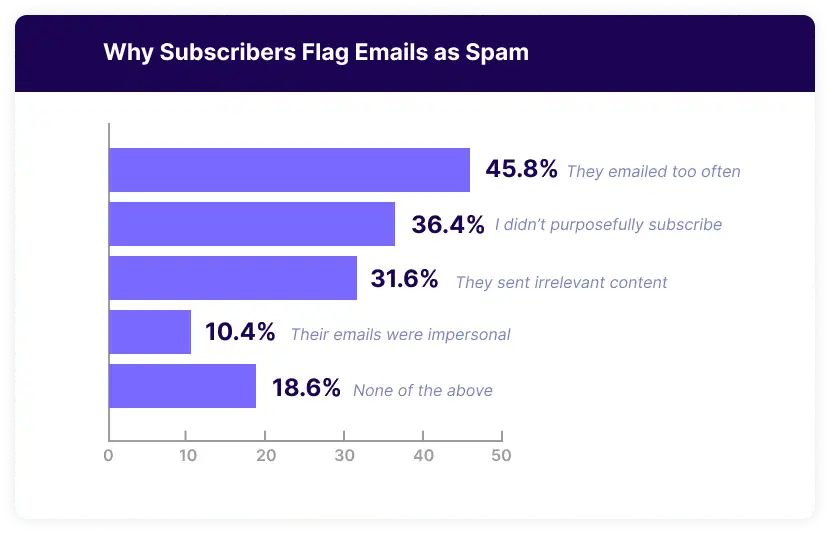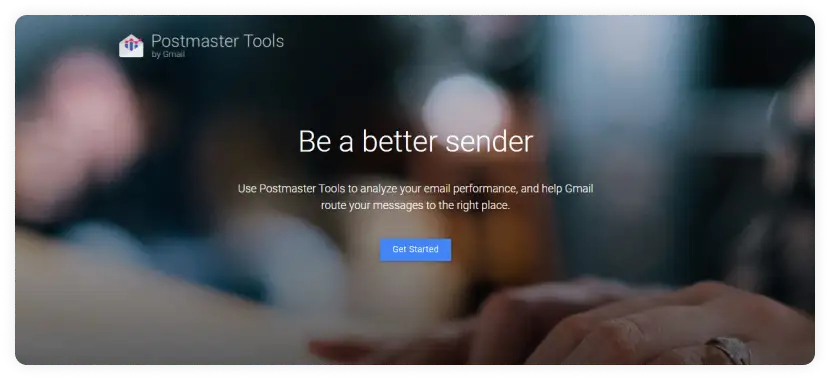It is every email marketer’s dream to achieve great email deliverability. And for that, you spend your days and nights improving domain reputation, avoiding spam filters, and adhering to the right email practices. You do whatever it takes to ensure the receiver’s inbox server accepts your email.
But you can still have bad email deliverability even after taking all these precautions. And this may happen owing to having a bad IP reputation. What’s worse is that it may not even be your fault.
That’s why in this guide, we’ll discuss the effects of IP address on your deliverability and how to improve it to create successful email campaigns.
Table of contents
What is a sender IP address?
As the name suggests, it is the IP address of the device used to send your emails. But don’t mistake it with your personal IP address. To clarify the confusion, here’s how they differ.
Personal IP address: The IP address of the device you're using your ESP from.
Sender IP address: The IP address of the device or server your ESP uses to send your emails.
So this means your ESP can decide the IPs it can use to send your emails. Additionally, your ESP may use the same IP to send emails of multiple brands. And that’s bad news for you. Let’s learn why.
What is IP reputation?
Every sender IP address has a reputation assigned by spam filters and inbox providers. And this is built over time – good or bad – depending on the marketers’ actions using this IP.
Why is IP reputation important?
Third-party spam filters and inbox providers will stop your emails from reaching users’ inboxes if your sender IP has a poor reputation. Here are the common reasons why your IP has a poor reputation:
It has received a lot of spam complaints.
It ended up in spam folders due to malicious attachments.
It was hit by spam traps.
On the other hand, having a great IP reputation will significantly increase your deliverability. Because if you have a great IP reputation, it means that you’re providing real value to your subscribers, and you’ll be rewarded for that.
So now you know the importance of IP reputation, it is now time to choose an IP address for your email campaigns, and there are two types for you to choose from.
Related guide: 9 Reasons Why Your Emails Land in Spam and What You Can Do About It
Shared and Dedicated IP address
A shared IP address is the one that multiple email senders use to send emails. You can see this happening with ESP providers, where when you configure your email campaign, it will assign an IP address to send your emails. And this ESP can use the same IP when other brands want to send their emails.
So the overall reputation of a shared IP is dependent on the actions of all the users who use it. Few bad apples and your reputation can go downhill.
On the other hand, a dedicated IP address is the one that a single user uses to send emails. This means that you have complete control over your IP reputation.
So depending on the needs of your email campaign, choose the appropriate type. But if you want to have a great IP reputation and are willing to put in the effort to maintain it, a dedicated IP address is the best choice.
Related guide: Dedicated IP Address vs. Shared IP Address - Which One Should You Use?
5 things that can hurt your IP reputation
Here are some reasons for a poor IP reputation:
👉 Users reporting you as spam
The spam stats below make it clear that your users will flag you as spam if you email too often or send irrelevant emails. They already receive hundreds of emails every day, so it better be relevant and of high quality if you want them to give you attention. If it isn’t, then they’ll mark you as spam, and hence the associated IP’s reputation will go downhill. Here were the responses of users when the question “For what reasons have you marked a business' emails as spam?” was asked.

👉 Using shared IP address
As mentioned above, the reputation of a shared IP address depends on the overall actions of its users. You may be following all the good email principles and sending valuable content. But if other people who use that IP don’t do that, it will get a bad reputation. And your email deliverability will get affected by that. So, it’s best to use a dedicated IP address to have more control over your reputation and deliverability.
👉 Not warming up your IP address
You may have just set up a new dedicated IP address and are excited to use it to send emails to your email list. But you’ve to do it gradually and not send hundreds of emails suddenly. If you do that, your IP’s reputation will fall. This is because your IP address is still new, and mailbox providers don’t know about it yet. So the sudden volume of your emails will send a spam signal to the mailbox providers.
👉 Sending non-strategic email blasts
Email blast is the practice of sending email to your entire list all at once. Marketers may do this in the hope of getting more conversions but end up hurting their deliverability. Nowadays, every user wants specifically catered content that matches their likings. So if you send the same email to all your audience, obviously, not all your users will like it and will not open it. Hence, your open rates will be hurt, giving your sender IP a bad reputation.
👉 Not having a correct email marketing strategy
All the symptoms mentioned above result from not having the right email marketing strategy. If you don’t know how you’ll welcome your new subscribers, manage existing users, remove unsubscribed users, be compliant with email laws, the decrease in your IP reputation becomes self-explanatory.
5 proven ways to improve your IP reputation
There can be many reasons for a bad IP reputation, and you may not be able to improve all of them. But here are five tested tips you can use to improve your IP reputation:
1. Warm-up your new IP address
Don't behave like a spammer if you don’t want to end up in the spam folder. If you send a huge amount of emails with a new IP, the inbox providers will consider you a spammer. To avoid that, you’ve to warm up your new IP by sending your emails to a small group of people and gradually increasing the magnitude.
2. Implement a sunset policy
A brick wall will not respond to you no matter how much you talk to it. The same is the case with unengaged and inactive users. For whatever reason, these users have not engaged with your emails for a long time. So it’s time to form a Sunset policy which is nothing but the act of identifying these unengaged users and preparing a strategy to deal with them.
3. Avoid spam filters
Spam filters may seem like your enemies, but they are your friends. Spam filters are nothing but software algorithms that set up rules to identify spam. You must know these rules and take precautionary measurements if increasing deliverability is your priority. Not ending up in the spam folder frequently is a sign of good email etiquette, and ISPs will notice and reward you for it by increasing your deliverability.
4. Check if your IP address is blacklisted
Third-party blacklist databases such as Spamhaus can put your IP address on their blacklist. And since inbox providers use these third-party databases, they may not allow you to send emails or put you in spam. This will put a dent in your IP reputation and hurt your deliverability. So check if your IP is blacklisted by these platforms and get it removed ASAP.
5. Use dedicated IP addresses
As discussed earlier in the guide, a shared IP address can harm your deliverability due to the bad actions of other email senders. So to have an excellent IP reputation, set up a dedicated IP address, and follow the best email practices and principles.
3 tools to check IP reputation
There are many ways to check your IP reputation, and we are going to discuss three of those in this guide:
1. Google Postmaster

Google Postmaster is one of the most popular tools for checking your IP reputation. If you send emails at scale to a lot of Gmail users, this tool by Google can give you a pretty accurate picture of your IP reputation. To check your IP reputation with this tool, you must add your domain and verify it. Then you can check different things about your IP address, such as the IP reputation or domain reputation.
2. Cisco Talos Intelligence IP Checker

The Cisco Talos Intelligence IP Checker helps you check your IP and domain reputation. Enter your sender's IP address and hit search to check your IP reputation. Then you’ll see the overview of your IP’s credentials, including its reputation. This tool also tells you if your IP is listed on other blocklists. You can also check that and submit a request to remove it.
3. Sender score from Validity

The Sender score from Validity rates you from zero to 100. If your sender score is between 0-70, it means that your sender's reputation is bad, and you’ve to improve it. A score between 70-80 means that your IP is good, and you’ve to work on maintaining it. A score above 80+ is an excellent score, and you may even qualify for their certification program, which will provide you special treatment from the mailbox providers.
Wrap up
A low IP reputation can drastically damage your email deliverability despite the compelling subject lines, engaging email copy, and CTA. But as long as you follow our easy tips, you have nothing to worry about.
IP reputation is only the tip of the iceberg, though. It is equally important to have a strong domain reputation to monitor higher email deliverability. Are you looking to build your domain reputation? Read our guide for some quick-fix hacks!
What you should do next
Hey there, thanks for reading till the end. Here are 3 ways we can help you grow your business:
Talk to an email expert. Need someone to take your email marketing to the next level? Mailmodo’s experts are here for you. Schedule a 30-minute email consultation. Don’t worry, it’s on the house. Book a meet here.
Send emails that bring higher conversions. Mailmodo is an ESP that helps you to create and send app-like interactive emails with forms, carts, calendars, games, and other widgets for higher conversions. Get started for free.
Get smarter with our email resources. Explore all our knowledge base here and learn about email marketing, marketing strategies, best practices, growth hacks, case studies, templates, and more. Access guides here.


